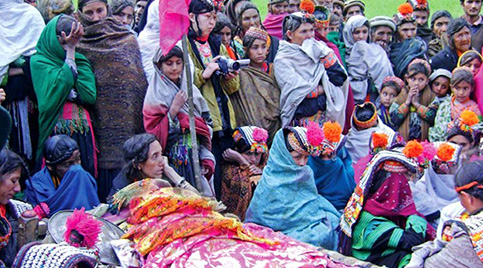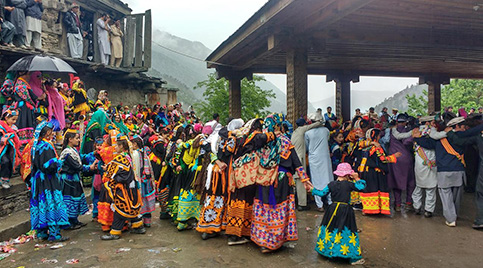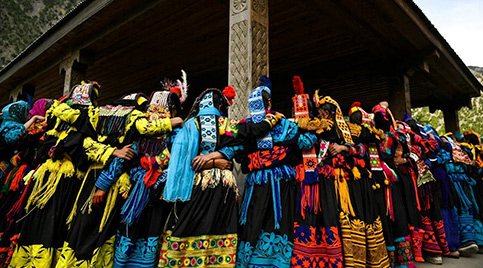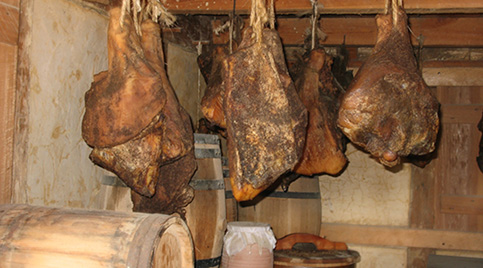The picturesque city of Kafiristan lies in Afghanistan and Pakistan. It lies on the Pak-Afghan border. It stretches vertically from the majestic Hindu kush mountain range to the breathtaking Kunar valley; and horizontally from the glistening Alishang river to the stunning Chitral district. The valley is 2 km away from the Chitral district of Pakistan. Let’s learn about the people of Kafiristan in this article.
This area is also known as the Kalash valley. The people of Kalash speak Kalashu and are known as the Kalathas. Kafiristans current population is around 4000. They are considered among the indigenous minorities, as they belong to the Indo-Aryan tribe. The Kalash believe themselves to be descendants of Alexander the great – a great warrior who stretched his empire from Egypt to Macedonia for 13 years.
Read more: The feisty festivals of Kalash
Identity and Ethnicity of the People of Kafiristan
The city got its name from its blended belief system. The word “kafir” means infidel, a non-believer, and “stan” means state. They used to follow one of the ancient Buddhist teachings, but later they adopted traditions of different cultures and religions into their beliefs and made them their own. They denied many religions completely and chose happiness, so they made a religion that brought them joy. The Kalashas have many practices which are not common throughout the world.
Culture of The People of Kafiristan
The Kalash culture is very different from its surrounding religions. The people of Kafiristan, although located in a Muslim majority country, follow very different traditions. Their unique practices are a vital part of the reason tourists are interested in this place.
They speak Kalashu, which is a mix of Sanskrit and Farsi. The people here follow Zoroastrian, Buddhist, and a combination of other beliefs as well. Some part of their population has accepted Islam as well. Their only religion is known to be happiness, and even deaths are celebrated like birth.
They are known to be very celebratory people. Skillful dances and animal sacrifices are a regular part of their celebrations.
In the Kalash valley, there’s a village called Balashi, where only women and babies are allowed. Balash is the word used for infants in their language. Women are supposed to be paak after childbirth before meeting the husband. Being paak means to wait 40 days since; that’s how long it takes for your body to clean itself, and relax after childbirth(according to Islamic beliefs).
Related: Exploring the history and culture of art and craft in Pakistan
Death
When a person passes away in Kafiristan, thousands of men and women gather, not to mourn but to celebrate; to liberate their souls to the afterlife. The deceased stay in their community hall for a day where people come to see them, sing and dance around them, and look at them. Many traditions follow a funeral, starting with sacrificing cattle to feed the guests. They spend time partying, drinking alcohol, firing at the sky, dancing and singing. Another practice is to put cigarettes, alcohol, and money next to the deceased.
The people of Kafiristan used to put the bodies in a stone coffin and leave it in a vacant area. Now they bury the dead. The cost of a funeral in this valley can range from 8 to 40 lakh rupees.
Marriage Customs of the People of Kafiristan
Their difference in their practices doesn’t disappoint when it comes to getting married. The bride and groom run away together to marry. However, their families and notable townspeople know about this beforehand. After they come back to their village, the families ask the girl if she, by her free will, is consenting to this marriage; this is to ensure happiness for the couple and to know that the girl was not under pressure to agree. This ceremony ends after the girl answers. The commencement of the celebrations depends on her response.
Only the bridal party attends the marriage ceremony. Then both families join in the after-party. On the fourth day after the wedding, the girl’s uncle visits the boy’s family. There, they gift him a gun and an ox. This is a commencement of the thoughtful exchange of gifs between the two families. This continues for multiple days.
Another rule they follow is that a girl can run away with another guy. Even while she is a married woman. Her husband or his family do not have a say in this. The people from Kalash valley can marry people from other religions as well.
Birth 
After marriage, the Kalasha waits for a child (a reason to celebrate). When the child is born, a ceremony takes place which; arranged by the mother’s family. However, the father’s side of the family has to pay for the celebration. During the function, the husband has to give 2000 rupees to each member of his in-laws. The festivities take place repeatedly until a child of a different gender is born.
For example, if a woman gives birth to a girl, the celebration will take place. If she has another girl, the celebration will take place; again. The festivities will repeat for all the times she bears a girl consecutively. The people of Kafiristan will stop when she births a boy.
Dressing 
The women of Kafiristan wear long black dresses embellished with colorful embroidery and intricate beadwork. The people of Chitral know them as “Siahposh”; Siah means black and posh means wearer.
The Kalash women wear headdresses constructed with cowrie shells and beads woven together. Their headdresses appear in all sizes and lengths. During weddings, we customarily see the bride wearing the longest, most stunning headdress with intricate beadwork.
The women glisten in the bright shades of red, orange, pink, yellow, blue, and more. They decorate their necks with chunky necklaces. That is made with cowrie shells but heavier and thicker beads.
The men wear everyday clothes worn by Pakistani men, known as shalwar kameez. Adding their flair to it, they wear a wool cap with a feather in the front. Men in many other Kalash villages wear this as well.
Related: Top 15 best places in Pakistan that you need to visit
Preservation 
The people of Kafiristan face a hindrance – to save their system, language, and culture. In 2009, Taliban abducts a Greek social worker. He was working to preserve the Kalash. His name was Larounis. They released him after he promised to return to greek.
Without any help, the matter of preservation got worse. The belief stems from happiness, so marrying for love is not new. Recently Kalash women have been falling in love with and marrying non-Kalash men and converting to another religion.
Another reason for their conversion is the expenses. Their celebrations cost millions of rupees, and they have multiple functions throughout the year. People grow sick of having to spend and leave their religion.
A decade ago, the population of Kalashus in Kafiristan was 15000, and now it’s only 4000.
A majority of that tribe now has converted to Islam willingly. Even though in mid 20 century, Muslims tried to force Islam onto many Indo-Aryan tribes who lived according to ancient Buddhist beliefs, they fought to get rid of the pressure. Now more than half of the Kalash have converted to Islam or Christianity.
The conversions have had many NGOs worried. They have started funding separate bank accounts for individuals from Kafiristan, so they do not convert; they receive monthly payments. Europeans have also begun to adopt Kalash babies after birth to stop them from converting.